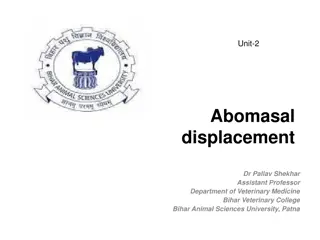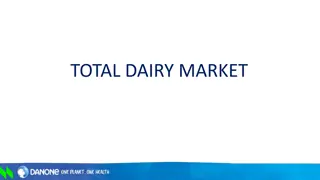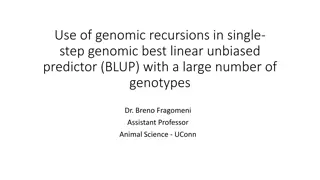Genetic Improvement of Dairy Cattle: Key Components and Strategies
Understanding the genetic improvement of dairy cattle is crucial for enhancing milk production. This article explores the key components involved, such as unique identification systems, parentage recording, milk yield monitoring, artificial insemination, and genetic evaluation methods. Achieving exceptional genetic progress in dairy cattle relies on effectively implementing these factors. The evolution of identification systems and the importance of pedigree recording in selecting superior breeding stock are also discussed.
Download Presentation

Please find below an Image/Link to download the presentation.
The content on the website is provided AS IS for your information and personal use only. It may not be sold, licensed, or shared on other websites without obtaining consent from the author. Download presentation by click this link. If you encounter any issues during the download, it is possible that the publisher has removed the file from their server.
E N D
Presentation Transcript
BIHAR ANIMAL SCIENCES UNIVERSITY, PATNA, BIHAR Bihar Veterinary College, Patna Components of Genetic Improvement of Dairy Cattle Speaker: Ramesh Kumar Singh Assistant Professor cum Jr. Scientist Department of Animal Genetics and Breeding Bihar Veterinary College, Patna
Introduction For thousands of years, the dairy cow has been a valuable producer of food for humans and animals. Animal breeding began when owners decided that mating the best with the best was a winning strategy. choosing which animals are best requires considerable insight. As genetic principles were discovered, animal breeding transformed into a science Early cattle gave only a few litters of milk per day; some herds now average 40 L/ cow/day, and a few individual cows have averaged over 80 L/day for an entire year. Although much has been learned about how to feed and manage dairy cows to obtain larger quantities of milk, current yield efficiency would not have been achieved unless concurrent progress had been made in concentrating those genes that are favourable for sustained, high milk production.
Genetic Improvement Steps Five factors are primarily responsible for the exceptional genetic improvement achieved by dairy cattle: 1) Permanent unique identification (ID); 2) Parentage recording 3) Recording of milk yield and other traits of economic importance 4) Artificial insemination (AI) 5) Accurate genetic evaluation systems. Ironically, failure of any one factor effectively neutralizes most genetic improvement.
Permanent unique identification (ID) Systems for dairy cattle ID have evolved from being unique to the farm to being unique internationally. Although five characters or digits are sufficient to be unique within a herd, today s international dairy industry requires a 19character ID number: 3-letter country code, 3-letter breed code, 1-letter gender code, and 12-digit animal number. Global ID has come at a price; larger ID numbers contribute to more data entry errors. Electronic ID tags and readers are becoming more common for managing feeding, milking, breeding, and health care of individual cows with the data transferred to an on-farm computer, especially for large herds. In some countries, unique ID for each animal is mandatory.
Parentage recording (Pedigree) Genetic improvement was slow before breeders began to summarize and use performance information from bulls daughters. Proper recording of sire ID was required for this advance and has been used throughout the last century in selection decisions. Proper recording of dam ID was also encouraged to accurate estimates of genetic merit. Cows of high genetic merit were designated as elite and usually were mated to top sires to provide young bulls for progeny-test programs of AI organizations. Genetic evaluation systems today use sophisticated statistical models that can include performance information from many or all known pedigree relationships.
Performance recording Little genetic improvement can be achieved without objective measurement of traits targeted for improvement. Countries vary considerably in percentage of cows that are in milk- recording programs. In the United States, almost 50% of dairy cows are enrolled in a dairy records management program, which supplies performance records to the national database. Parentage of only about two-thirds of those cows is known.
The first traits to be evaluated in most countries were milk and butterfat yield and percentage. Since the 1970s, accurate evaluation of protein yield and percentage, conformation traits, calving traits (calving ease / dystocia, stillbirth/calf survival, calf size / birth weight and gestation length), longevity (herd life, productive life, stayability, survival, and risk of involuntary culling), mastitis resistance (udder health / traits, somatic cell count / score and clinical mastitis) female fertility (heifer and cow conception rates, daughter pregnancy rate, non-return rate, number of inseminations, days open, calving interval, and other reproductive intervals) workability (milking speed and temperament) have been initiated in many countries.
Artificial Insemination Because some dilution of semen can provide nearly as high a conception rate as the original collected sample, 100 progeny or more can originate from a single ejaculate. In addition, semen can be frozen and kept for decades without any serious compromise to fertility. The ability to extend and freeze semen while achieving satisfactory fertility facilitates progeny testing early in a bull s life. Whether the bull is transmitting favourable traits to his offspring. After distribution of semen for a progeny test, most bulls traditionally were held in waiting until the outcome of the progeny test. Progeny testing many bulls provided an opportunity to select from among them, keep only the best, and use those few bulls to produce several thousand daughters and, in some cases, millions of granddaughters.
Genetic evaluation systems Traditional Accurate methods for evaluating genetic merit of bulls and cows for economically important traits are needed to identify those animals that are best suited to be parents of the next generation. The degree of system sophistication needed depends partially on effectiveness of the sampling program in randomizing bull daughters across herds that represent various management levels. If randomization is equitable for all bulls, less sophisticated procedures can be used. The methodology for evaluations has progressed from daughter dam comparison (1936) to herd mate comparison (1960) to modified contemporary comparison (1974) and finally to an animal model (1989).
A recent development in genetic evaluation systems is the use of test-day models, which have been adopted by several countries. Because test-day models account better for environmental effects and variations in testing schemes, they can provide more accurate estimates of genetic merit than do lactation models. Once evaluations are released to the dairy industry, dairy farmers have an opportunity to select among the best bulls for their needs and purchase frozen semen marketed by AI organizations. Mating decisions for specific animals can be based on estimated genetic merit for individual traits or selection indexes that combine traits of economic interest.























